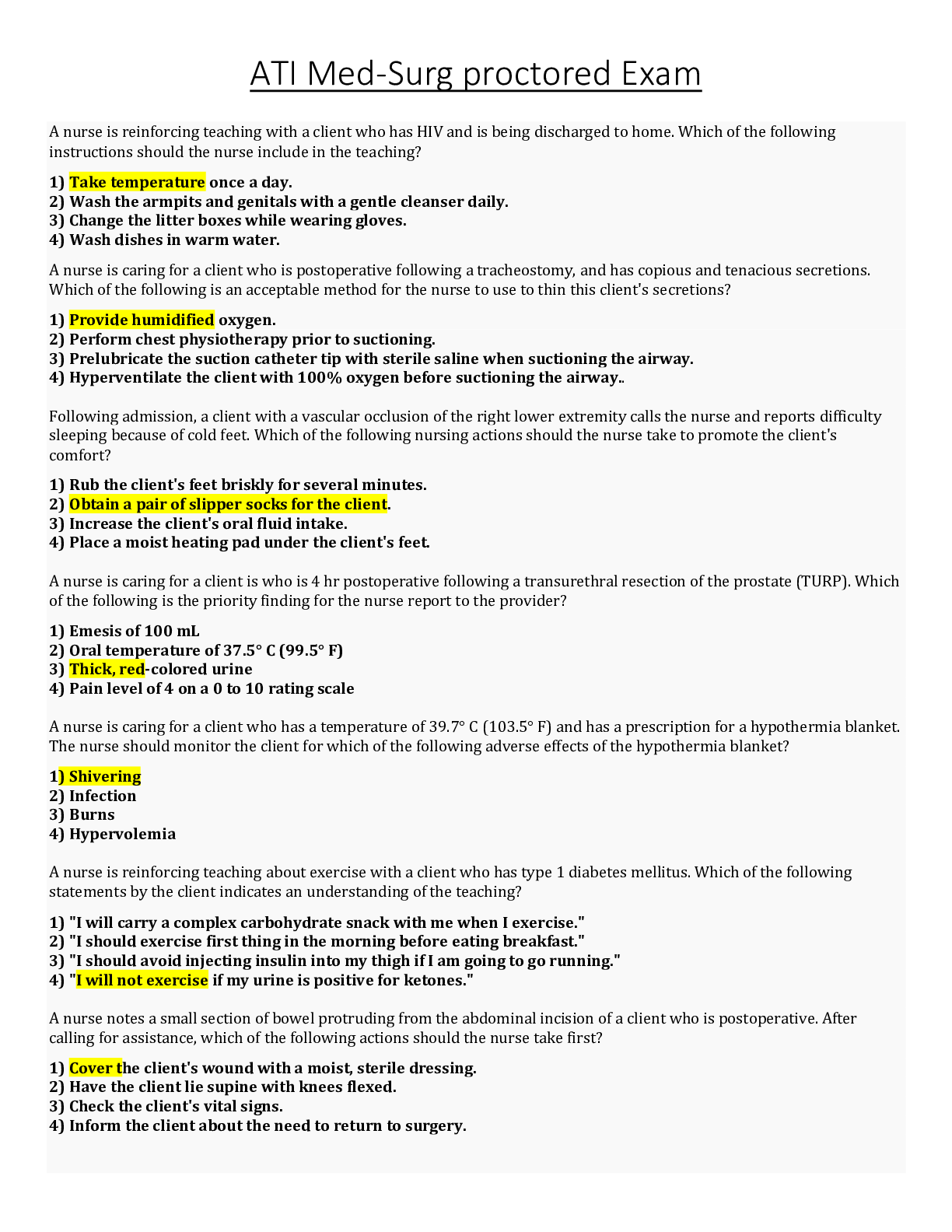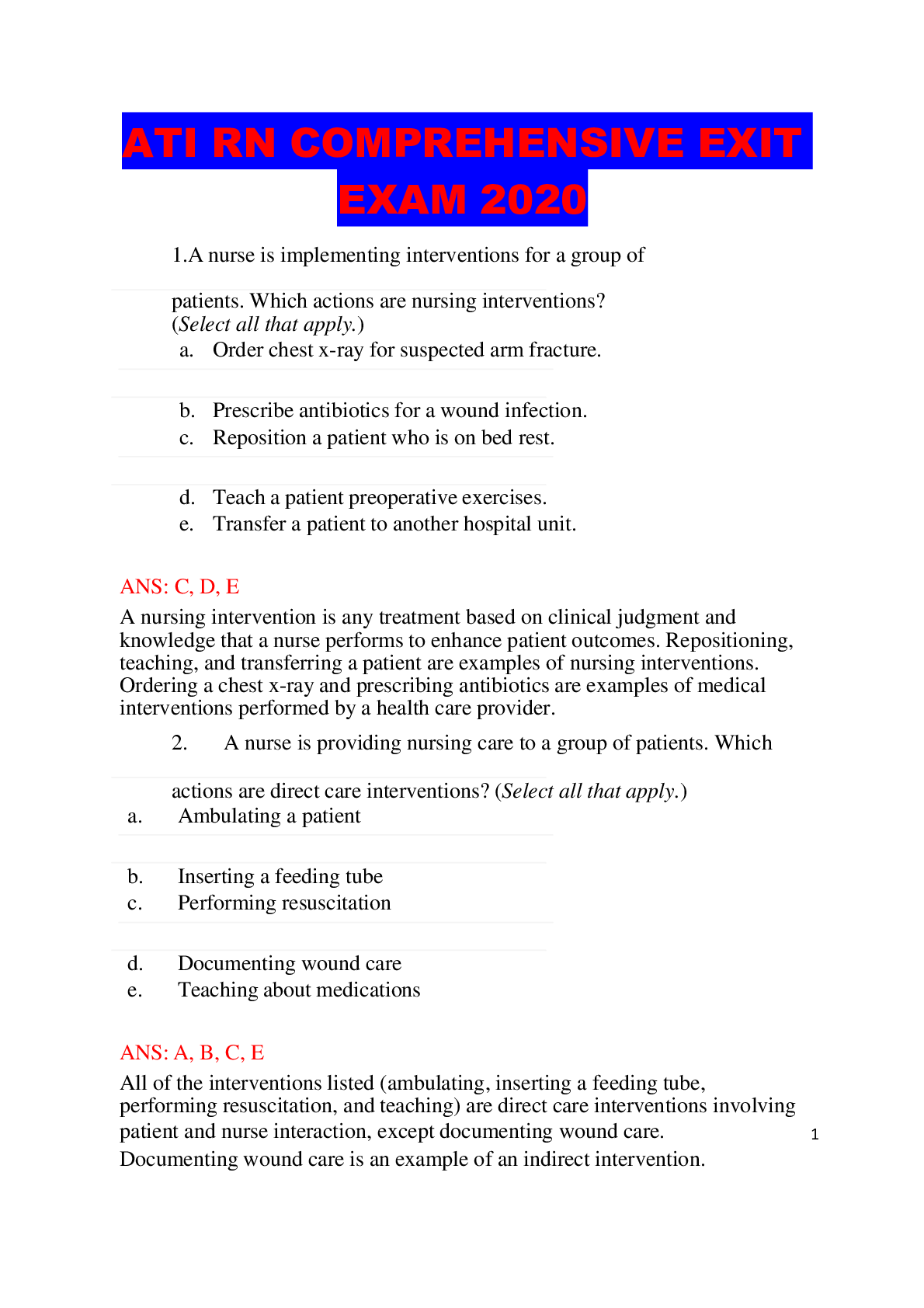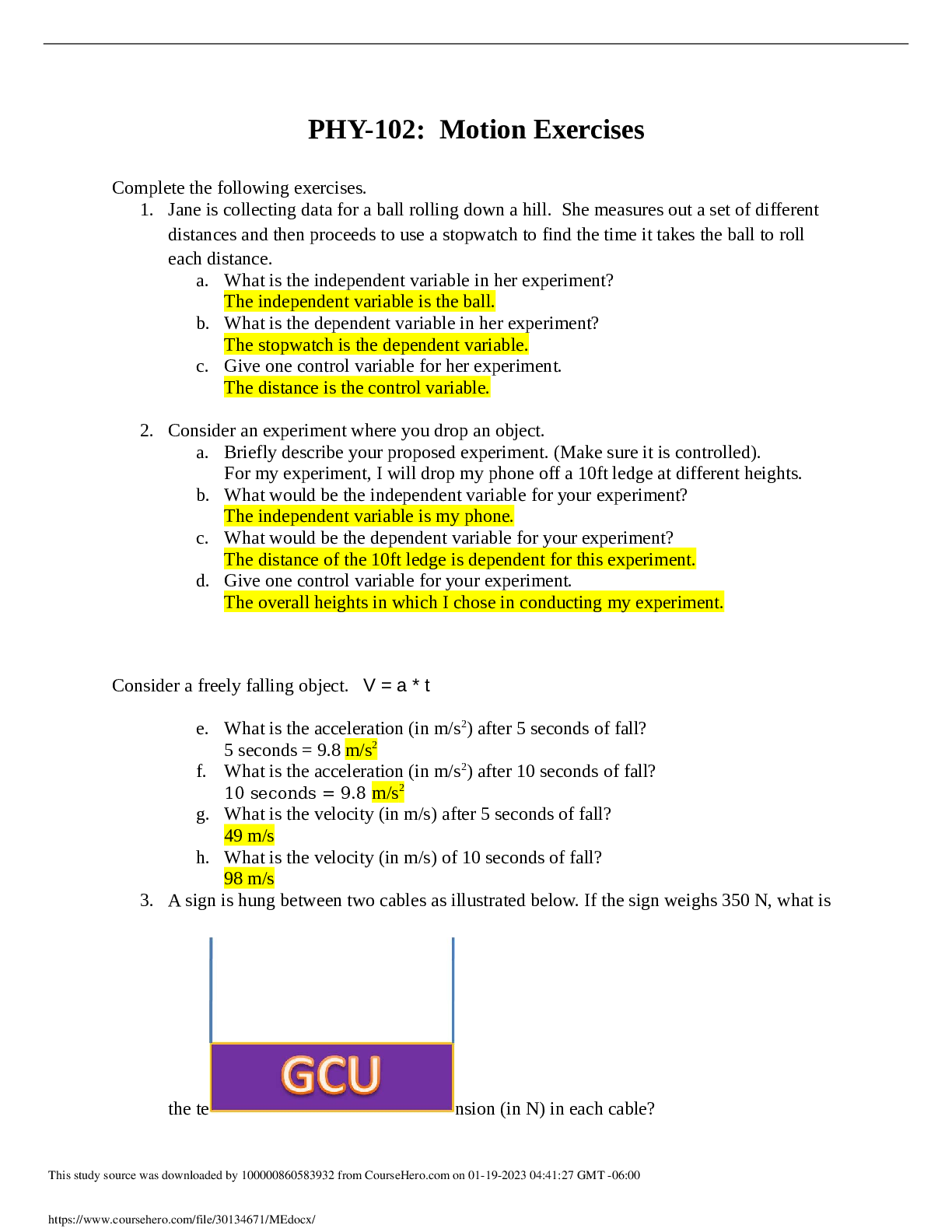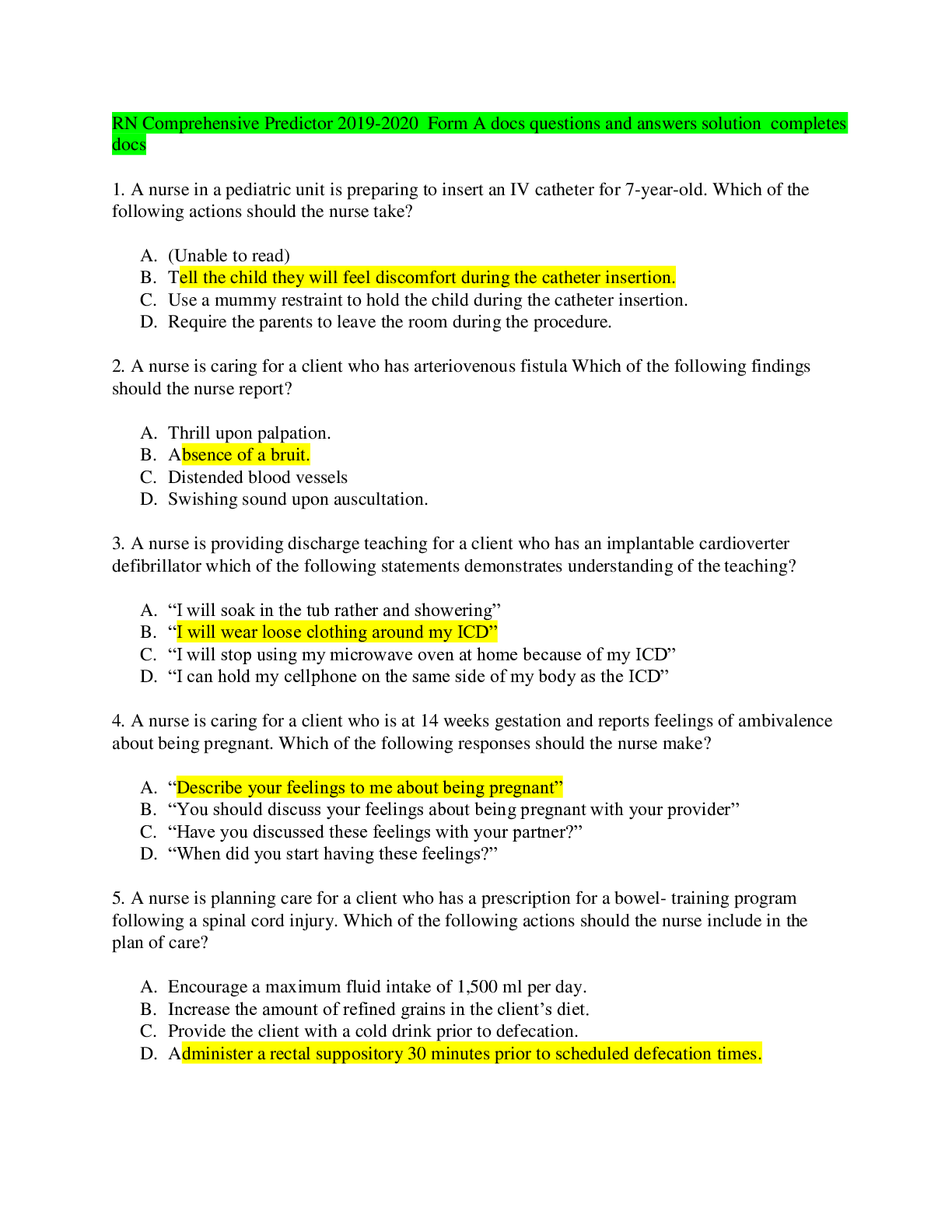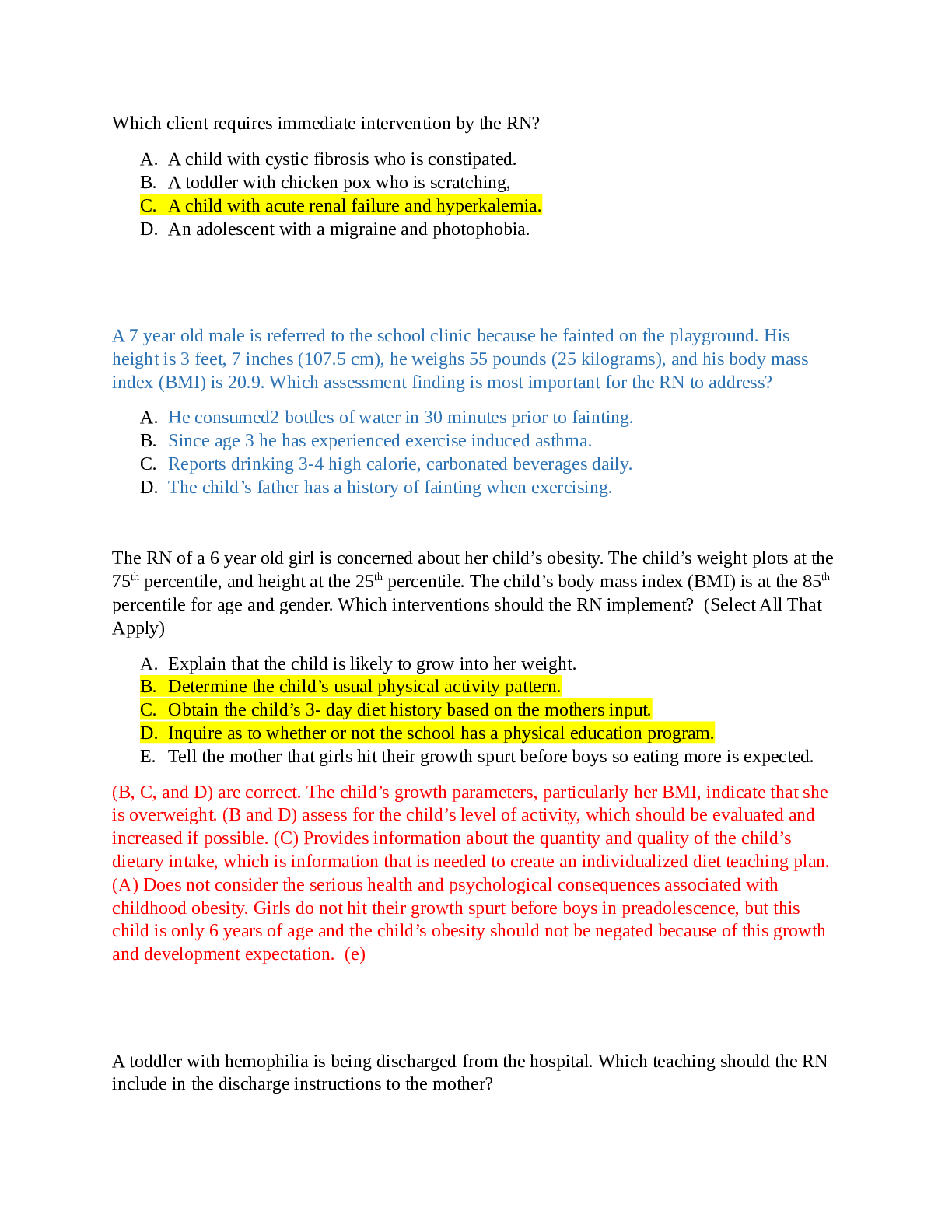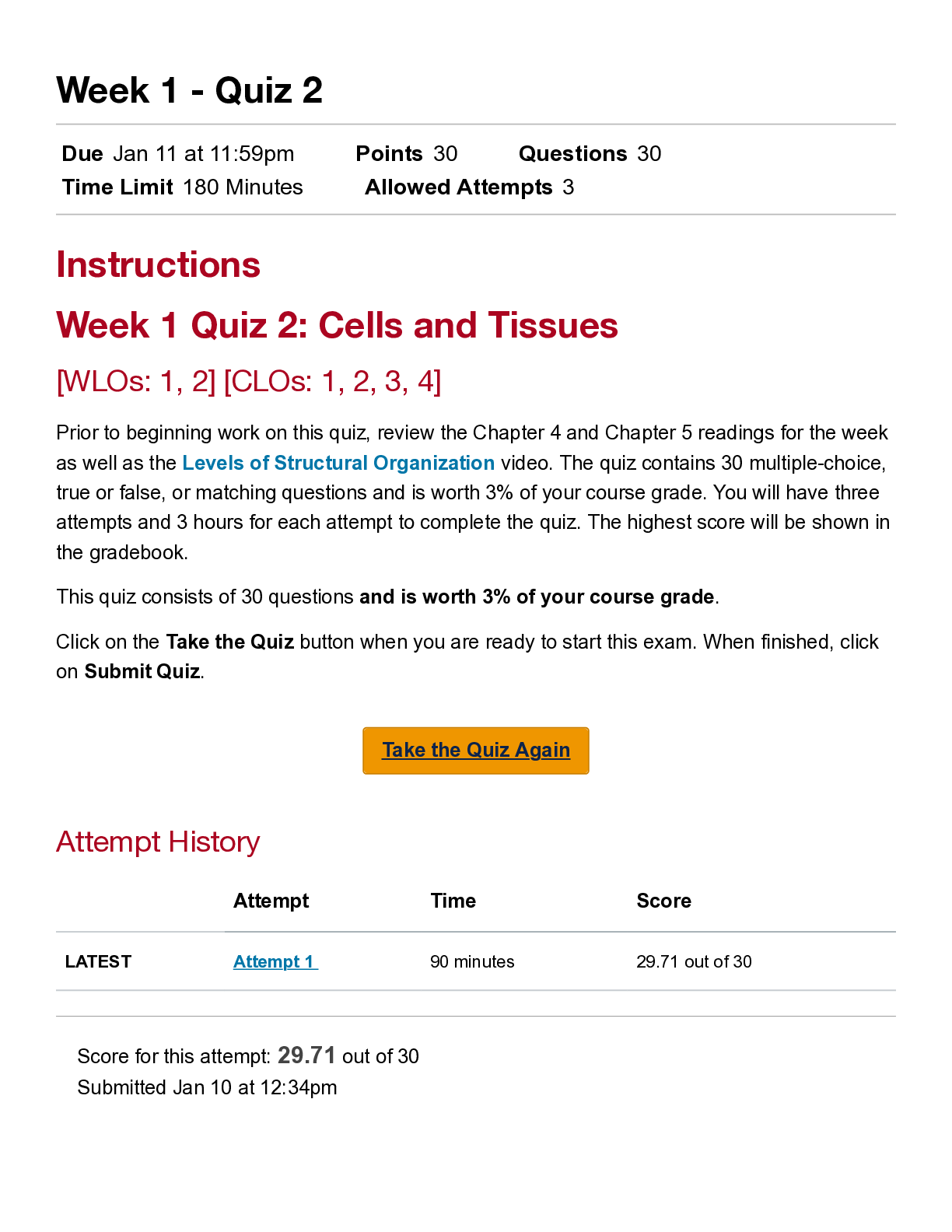*NURSING > EXAM > PN2 NUR 2571 PN 2 Exam Help test prep with complete Questions and answers Graded A (All)
PN2 NUR 2571 PN 2 Exam Help test prep with complete Questions and answers Graded A
Document Content and Description Below
PN2 NUR 2571 PN 2 Exam Help test prep with complete Questions and answers Graded A PN 2 Exam 1 Questions & Answers. 1. A client has a tracheostomy tube in place. When the nurse suctions the client, f... ood particles are noted. What action by the nurse is best? b. Measure and compare cuff pressures. ANS: B 2. A nurse assesses a client after an open lung biopsy. Which assessment finding is matched with the correct intervention? c. Client has reduced breath sounds. Nurse calls physician immediately. ANS: C 3. A nurse assesses a clients respiratory status. Which information is of highest priority for the nurse to obtain? d. Occupation and hobbies ANS: D 4. A nurse assesses a client who is experiencing an acid-base imbalance. The clients arterial blood gas values are pH 7.34, PaO2 88 mm Hg, PaCO2 38 mm Hg, and HCO3 19 mEq/L. Which assessment should the nurse perform first? a. Cardiac rate and rhythm ANS: A 5. A nurse assesses a client who is admitted with an acid-base imbalance. The clients arterial blood gas values are pH 7.32, PaO2 85 mm Hg, PaCO2 34 mm Hg, and HCO3 16 mEq/L. What action should the nurse take next? a. Assess clients rate, rhythm, and depth of respiration. 6. A nurse is assessing a client who is recovering from a lung biopsy. Which assessment finding requires immediate action? b. Absent breath sounds ANS: B 7. A nurse is caring for a client who has just experienced a 90-second tonic-clonic seizure. The clients arterial blood gas values are pH 6.88, PaO2 50 mm Hg, PaCO2 60 mm Hg, and HCO3 22 mEq/L. Which action should the nurse take first? a. Apply oxygen by mask or nasal cannula. 8. A nurse is caring for a client who is scheduled to undergo a thoracentesis. Which intervention should the nurse complete prior to the procedure? d. Validate that informed consent has been given by the client. ANS: D 9. A nurse assesses a client after a thoracentesis. Which assessment finding warrants immediate action? d. The trachea is deviated toward the opposite side of the neck. ANS: D 10.A nurse is caring for a client who has just had a central venous access line inserted. Which action should the nurse take next? b. Ensure an x-ray is completed to confirm placement. ANS: B 11.A nurse teaches a client who is being discharged home with a peripherally inserted central catheter (PICC). Which statement should the nurse include in this clients teaching? a. Avoid carrying your grandchild with the arm that has the central catheter. ANS: A 12.A nurse is caring for a client who is receiving an epidural infusion for pain management. Which assessment finding requires immediate intervention from the nurse? b. Report of headache and stiff neck ANS: B 13.A nurse is assessing clients who have intravenous therapy prescribed. Which assessment finding for a client with a peripherally inserted central catheter (PICC) requires immediate attention? d. Upper extremity swelling is noted. ANS: D 14.A nurse teaches a client who is prescribed a central vascular access device. Which statement should the nurse include in this clients teaching? c. Ask all providers to vigorously clean the connections prior to accessing the device. ANS: C 15.A nurse is caring for a client with a peripheral vascular access device who is experiencing pain, redness, and swelling at the site. After removing the device, which action should the nurse take to relieve pain? b. Place warm compresses on the site. ANS: B 16.A nurse prepares to flush a peripherally inserted central catheter (PICC) line with 50 units of heparin. The pharmacy supplies a multi-dose vial of heparin with a concentration of 100 units/mL. Which of the syringes shown below should the nurse use to draw up and administer the heparin? ANS: D (10-mL syringe picture) 17.A nurse assesses a client who has a peripherally inserted central catheter (PICC). For which complications should the nurse assess? (Select all that apply.) a. Phlebitis c. Thrombophlebitis ANS: A, C 18. While assessing a client who has facial trauma, the nurse auscultates stridor. The client is anxious and restless. Which action should the nurse take first? a. Contact the provider and prepare for intubation. ANS: A 19.A nurse assesses a clients peripheral IV site, and notices edema and tenderness above the site. Which action should the nurse take next? d. Stop the infusion of intravenous fluids. 20. A nurse assesses a client who has facial trauma. Which assessment findings require immediate intervention? (Select all that apply.) a. Stridor d. Ecchymosis behind the ear ANS: A, D 21. A nurse is caring for a client who is experiencing excessive diarrhea. The clients arterial blood gas values are pH 7.28, PaO2 98 mm Hg, PaCO2 45 mm Hg, and HCO3 16 mEq/L. Which provider order should the nurse expect to receive? b. Sodium bicarbonate 100 mEq diluted in 1 L of D5W 22. A nurse assesses clients on the medical-surgical unit. Which client is at greatest risk for development of obstructive sleep apnea? c. A 55-year-old woman who is 50 pounds overweight ANS: C 23. A nurse cares for a client who is experiencing epistaxis. Which action should the nurse take first? a. Initiate Standard Precautions. ANS: A 24.A client is prescribed 250 mL of normal saline to infuse over 4 hours via gravity. The facility supplies gravity tubing with a drip factor of 15 drops/mL. At what rate (drops/min) should the nurse set the infusion to ANS: 16 drops/min 25.A client is prescribed 1000 mL of normal saline to infuse over 24 hours. At what rate should the nurse set the pump (mL/hr) to deliver this infusion? (Record your answer using a whole number.) ____ mL/hr ANS:42--1000 mL 24 hours = 41.6 mL/hr. (42 is the answer) 26. A nurse is caring for a client who has sleep apnea and is prescribed modafinil (Provigil). The client asks, How will this medication help me? How should the nurse respond? c. This medication will promote daytime wakefulness. ANS: C 27. A nurse assesses a client who has developed epistaxis. Which conditions in the clients history should the nurse identify as potential contributors to this problem? (Select all that apply.) b. Hypertension c. Leukemia d. Cocaine use ANS: B, C, D 28. After teaching a client who is prescribed a long-acting beta2 agonist medication, a nurse assesses the clients understanding. Which statement indicates the client comprehends the teaching? c. I will take this medication every morning to help prevent an acute attack. ANS: C 29. A nurse is teaching a client who has cystic fibrosis (CF). Which statement should the nurse include in this clients teaching? c. Eat a well-balanced, nutritious diet. ANS: C 30. While assessing a client who is 12 hours postoperative after a thoracotomy for lung cancer, a nurse notices that the lower chest tube is dislodged. Which action should the nurse take first? b. Cover the insertion site with sterile gauze. ANS: B 31. A nurse cares for a client who had a chest tube placed 6 hours ago and refuses to take deep breaths because of the pain. Which action should the nurse take? d. Administer pain medication and encourage the client to take deep breaths. ANS: D 32. A nurse cares for a client who has a chest tube. When would this client be at highest risk for developing a pneumothorax? d. When the tube becomes disconnected from the drainage system ANS: D 33. The nurse is caring for a client who is prescribed a long-acting beta2 agonist. The client states, The medication is too expensive to use every day. I only use my inhaler when I have an attack. How should the nurse respond? d. It is important to use this type of inhaler every day. Lets identify potential community services to help you. ANS: D 34. A nurse assesses a client who has a chest tube. For which manifestations should the nurse immediately intervene? (Select all that apply.) b. Tracheal deviation c. Sudden onset of shortness of breath ANS: B, C 35. A nurse is caring for a client using oxygen while in the hospital. What assessment finding indicates that goals for a priority diagnosis are being met? b. Intact skin behind the ears 36. A nurse cares for a client who had a bronchoscopy 2 hours ago. The client asks for a drink of water. Which action should the nurse take next? c. Assess the clients gag reflex before giving any food or water. 37.A client has been diagnosed with tuberculosis (TB). What action by the nurse takes highest priority? a. Educating the client on adherence to the treatment regimen ANS: A 38.A nurse has educated a client on isoniazid (INH). What statement by the client indicates teaching has been effective? c. I will take this medication on an empty stomach. ANS: C 39. A client has a tracheostomy that is 3 days old. Upon assessment, the nurse notes the clients face is puffy and the eyelids are swollen. What action by the nurse takes priority? a. Assess the clients oxygen saturation. ANS: A 40.A client has been hospitalized with tuberculosis (TB). The clients spouse is fearful of entering the room where the client is in isolation and refuses to visit. What action by the nurse is best? a. Ask the spouse to explain the fear of visiting in further detail. ANS: A 41.A client is being discharged on long-term therapy for tuberculosis (TB). What referral by the nurse is most appropriate? d. Visiting Nurses for directly observed therapy ANS: D 42. A nurse assesses a client who has appendicitis. Which clinical manifestation should the nurse expect to find? a. Severe, steady right lower quadrant pain ANS: A 43. A nurse cares for an older adult client who has Salmonella food poisoning. The clients vital signs are heart rate: 102 beats/min, blood pressure: 98/55 mm Hg, respiratory rate: 22 breaths/min, and oxygen saturation: 92%. Which action should the nurse complete first? b. Administer intravenous fluids. ANS: B 44. A nurse assesses a client who is hospitalized with an exacerbation of Crohns disease. Which clinical manifestation should the nurse expect to find? c. High-pitched, rushing bowel sounds in the right lower quadrant ANS: C 45. After teaching a client who is prescribed adalimumab (Humira) for severe ulcerative colitis, the nurse assesses the clients understanding. Which statement made by the client indicates a need for additional teaching? b. I will take this medication with my breakfast each morning. ANS: B 46. A nurse cares for a client with chronic obstructive pulmonary disease (COPD). The client states that he no longer enjoys going out with his friends. How should the nurse respond? c. Share any thoughts and feelings that cause you to limit social activities. d. Friends can be a good support system for clients with chronic disorders. 47. A nurse assesses a client who has ulcerative colitis and severe diarrhea. Which assessment should the nurse complete first? c. Heart rate and rhythm ANS: C 48. A nurse cares for a client with chronic obstructive pulmonary disease (COPD) who appears thin and disheveled. Which question should the nurse ask first? c. Do you experience shortness of breath with basic activities? 49. A nurse cares for a client with ulcerative colitis. The client states,” I feel like I am tied to the toilet.” This disease is controlling my life. How should the nurse respond? a. Lets discuss potential factors that increase your symptoms. ANS: A 50. A nurse cares for a client who is prescribed mesalamine (Asacol) for ulcerative colitis. The client states, I am having trouble swallowing this pill. Which action should the nurse take? c. Ask the health care provider to prescribe the medication as an enema instead. ANS: C 51. A nurse assesses a client with ulcerative colitis. Which complications are paired correctly with their physiologic processes? (Select all that apply.) a. Lower gastrointestinal bleeding Erosion of the bowel wall b. Abscess formation Localized pockets of infection develop in the ulcerated bowel lining d. Nonmechanical bowel obstruction Paralysis of colon resulting from colorectal cancer ANS: A, B, D 52. The student nurse studying stomach disorders learns that the risk factors for acute gastritis include which of the following? (Select all that apply.) a. Alcohol b. Caffeine c. Corticosteroids e. Nonsteroidal anti-inflammatory drugs (NSAIDs) ANS: A, B, C, E 53. A client is recovering from an esophagogastroduodenoscopy (EGD) and requests something to drink. What action by the nurse is best? b. Assess the clients gag reflex. ANS: B 54. A nurse teaches a client who is at risk for colon cancer. Which dietary recommendation should the nurse teach this client? c. Add vegetables such as broccoli and cauliflower to your new diet. ANS: C 55. A nurse assesses a client who is admitted for treatment of fluid overload. Which manifestations should the nurse expect to find? (Select all that apply.) a. Increased pulse rate b. Distended neck veins e. Skeletal muscle weakness ANS: A, B, E 56.A nurse assesses a client who was started on intraperiton [Show More]
Last updated: 2 years ago
Preview 1 out of 16 pages

Buy this document to get the full access instantly
Instant Download Access after purchase
Buy NowInstant download
We Accept:

Reviews( 0 )
$12.00
Can't find what you want? Try our AI powered Search
Document information
Connected school, study & course
About the document
Uploaded On
Feb 13, 2021
Number of pages
16
Written in
Additional information
This document has been written for:
Uploaded
Feb 13, 2021
Downloads
0
Views
97

